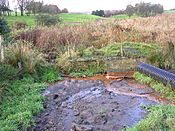River Irk facts for kids
Quick facts for kids River Irk |
|
|---|---|

The Irk at Crumpsall
|
|
|
Location of the mouth within Greater Manchester
|
|
| Country | England |
| Physical characteristics | |
| Main source | Royton |
| River mouth | River Irwell 53°29′12.93″N 2°14′42.13″W / 53.4869250°N 2.2450361°W |
The River Irk is a river in North West England. It flows through towns in the northern part of Greater Manchester.
The river starts east of Royton and flows west. It passes through Chadderton, Middleton, and Blackley. Finally, it joins the River Irwell in the center of Manchester.
Contents
History of the River Irk
The name 'Irk' might come from an old British language. It could be linked to the Welsh word iwrch, which means 'roebuck' (a type of deer). Another river in Wales, the Afon Iwrch, also has a similar name.
The Irk in Medieval Times
Long ago, in the Middle Ages, there was a mill on the Irk. People living nearby had to grind their corn there. The river also had fish, and the local lord controlled who could fish. In the 1500s, people were told not to throw trash or dead animals into the Irk. Before big factories started, Manchester got its water from this river.
Bridges and Floods
A bridge over the Irk was first mentioned in 1381. The river was known for causing big floods. In 1480, people in Manchester complained that the Irk had washed away a road. By 1816, there were seven bridges over the Irk. Six of them would flood after heavy rain. But the seventh, the Ducie Bridge, built in 1814, was high enough to stay above the floodwaters.
The Irk During the Industrial Revolution
In 1830, a book called The New Gazetteer of Lancashire said the Irk had more mills along its banks than any other river of its size in the country. It also mentioned that the eels in the river used to be very fat. People thought this was because of the grease and oils from the wool factories mixing with the water.
However, by the early 1900s, the Irk Valley between Crumpsall and Blackley was very neglected. The river was described as "not only the blackest but the most sluggish of all rivers."
Friedrich Engels, a famous writer, described the dirty banks of the Irk in Manchester. This was when the city's factories were at their busiest.
The Irk Today
Today, as the river reaches the city center, it flows underground. It goes into a brick tunnel beneath Manchester Victoria railway station at Ducie Bridge. The Irk then empties into the River Irwell under a railway bridge.
On August 15, 1953, a serious train accident happened near the Irk. A train from Manchester to Bury fell from a bridge over the River Irk. This happened after it crashed into another train. This event was known as the Irk Valley Junction disaster.
Tributaries of the Irk
The River Irk has several smaller streams that flow into it. These are called tributaries:
- Moston Brook (also known as Moss Brook)
- Boggart Hole Brook
- Heaton Brook
- Boardman Brook
- Wince Brook
- Springs Brook
- Whit Brook
- Trub Brook
- Tandle Hill Brook
- Thorp Brook
- Luzley Brook
- Long Brook
See also
 In Spanish: Río Irk para niños
In Spanish: Río Irk para niños




